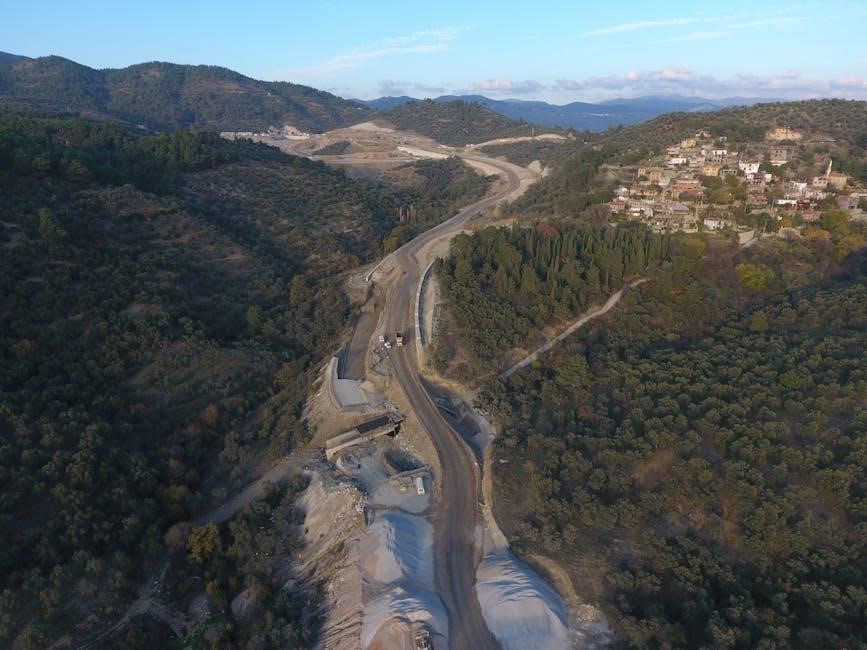Land survey symbols are graphical representations used on maps to depict various features․ These features include natural and man-made elements․ Comprehending these symbols unlocks understanding the terrain․ It is crucial for accurate interpretation․
Importance of Understanding Land Survey Symbols
Understanding land survey symbols is paramount for interpreting maps accurately, ensuring precision in property delineation and construction projects․ These symbols communicate vital information․ This information includes the location of boundaries, easements, utilities, and topographic features․ Accurate interpretation prevents disputes over property lines, avoiding costly legal battles and construction delays․ For engineers, developers, and landowners, these symbols are a common language․ This language facilitates communication and informed decision-making․ Recognizing symbols for water bodies and vegetation aids in environmental planning․ Furthermore, understanding road and railway symbols is essential for infrastructure development․ Mastery of land survey symbols enhances efficiency in land management․ It supports sustainable development and protects property rights․ A clear grasp ensures compliance with regulations․ This results in safer, more effective projects․ Ultimately, it helps foster better communication among stakeholders․ Land survey symbols are indispensable for anyone involved in land-related activities․ This includes planning, design, or management․
Purpose of Land Survey Symbols in Maps
Land survey symbols serve as a concise and standardized visual language within maps․ They effectively communicate complex information about land features, boundaries, and infrastructure․ Without these symbols, maps would be cluttered with excessive text․ This makes interpretation difficult and prone to errors; The primary purpose is to offer a clear, unambiguous representation of real-world elements on a scaled-down format․ This enhances map readability and usability for surveyors, engineers, and landowners․ By using established symbols, maps maintain consistency and accuracy across different regions and projects․ This standardization is crucial for legal and regulatory compliance․ Symbols for utilities, such as pipelines and power lines, are essential for safety and planning․ This allows one to avoid potential hazards during construction or excavation․ Topographic symbols depict elevation changes and natural features․ This aids in environmental assessment and land management․ Ultimately, land survey symbols streamline communication, prevent misunderstandings, and facilitate informed decision-making in all land-related endeavors․

Common Categories of Land Survey Symbols
Land survey symbols are grouped into categories for clarity․ These categories include boundary markers, topographic features, and utilities․ Understanding these categories helps in deciphering maps․ It also ensures accurate land interpretation․

Boundary Markers
Boundary markers are crucial in land surveys, delineating property lines and establishing legal boundaries․ These markers come in various forms, each represented by a specific symbol on survey maps․ Common boundary marker symbols include those for property corners, which indicate the exact points where property lines intersect․ These are often represented by circles, squares, or triangles, sometimes with additional markings to denote the type of monument found, such as iron pins or concrete monuments․
Other symbols depict different types of boundary evidence, such as fences, walls, or hedges that follow property lines․ These linear features are typically shown as solid or dashed lines, depending on their characteristics and reliability as boundary indicators․ Understanding boundary marker symbols is essential for accurately interpreting land survey maps and determining property ownership․ Accurate identification prevents disputes and ensures compliance with legal descriptions․ It is of utmost importance․
Topographic Features
Topographic features are natural and artificial formations that shape the earth’s surface․ Land surveys accurately map these features using distinct symbols․ These symbols provide vital information about the terrain’s elevation, shape, and composition․ Contour lines are a fundamental element, representing lines of equal elevation․ Closely spaced lines indicate steep slopes, while widely spaced lines denote gentle slopes․ Spot elevations, marked with an “x” or a dot and a numerical value, show the exact height of specific points․
Symbols also represent landforms like hills, valleys, ridges, and depressions․ These features are depicted using shading, hachures (short lines indicating slope direction), or contour patterns․ Additionally, symbols represent vegetation, such as forests, grasslands, and cultivated areas, providing context to the terrain․ Accurately interpreting these topographic symbols is crucial for understanding the landscape․ This understanding aids in planning, development, and environmental management․ It enhances decision-making processes․
Utilities and Infrastructure

Land surveys meticulously document utilities and infrastructure using specific symbols․ These symbols denote the location and type of underground and above-ground systems․ This ensures accurate mapping and facilitates safe excavation and maintenance․ Common utilities represented include water lines, sewer lines, gas lines, and electrical conduits․ Each utility has a unique symbol, often accompanied by labels indicating size and material․ Infrastructure elements like manholes, fire hydrants, and utility poles are also precisely marked․

Furthermore, symbols depict transportation infrastructure such as roads, railways, bridges, and tunnels․ Road symbols differentiate between paved and unpaved surfaces, indicating width and number of lanes․ Railway symbols show track locations, sidings, and railway crossings․ Understanding these symbols is crucial for urban planning, construction projects, and emergency response․ It ensures that infrastructure is properly managed and protected․ Precise mapping minimizes disruptions and prevents accidents․

Detailed Explanation of Specific Symbols
A deep dive into specific symbols is crucial․ This covers property corners, easements, water bodies, vegetation, and roads․ Each symbol provides unique information․ Accurate identification ensures precise map interpretation, vital for land management․
Symbols for Property Corners
Property corner symbols are fundamental in land surveys․ They denote the precise locations where property lines intersect, defining legal boundaries․ Various symbols exist, representing different types of markers found in the field․ These include iron pins, concrete monuments, and even natural features used as boundary references․
Understanding these symbols is essential for accurately determining property ownership․ A common symbol is a circle with a cross inside, indicating a found iron pin․ A triangle might represent a concrete monument set during a previous survey․ Sometimes, a combination of symbols is used to show the type and condition of the marker․
The legend of the survey map will explain the specific meaning of each property corner symbol․ It’s crucial to consult the legend to avoid misinterpretations․ These symbols are the cornerstone of accurate land demarcation and legal property descriptions․
Symbols for Easements
Easements are legal rights granted to a party․ This allows usage of another’s property for a specific purpose․ These rights are depicted on survey maps using distinct symbols․ It indicates the location and extent of the easement area․ Common easement symbols include dashed lines, often accompanied by abbreviations․ These abbreviations clarify the type, like “UTIL ESMT” for utility easements․
The width and alignment of the dashed line represent the easement’s physical dimensions․ Different patterns may indicate various easement types․ Examples include access easements, drainage easements, or utility easements․ Surveyors meticulously map these areas to ensure clarity․
The legend of the survey map contains vital details about each easement symbol; It specifies the responsible party and the restrictions․ Careful interpretation is crucial to understand the legal rights and limitations․ These symbols are indispensable for property transactions and development projects․
Symbols for Water Bodies
Water bodies are integral parts of any landscape․ They are represented on land surveys using a variety of symbols․ These symbols denote different types of water features․ This includes rivers, lakes, ponds, streams, and wetlands․ Typically, water bodies are depicted in blue․ This is done to visually distinguish them from other features on the map․
Symbols for larger water bodies like lakes and rivers often involve filled polygons․ The shape corresponds to the actual water body’s outline․ Smaller features like streams may be represented using single or double lines․ The line width and style can indicate stream size and flow characteristics․
Wetlands are often indicated by a combination of blue and green․ This often incorporates specific wetland vegetation symbols․ Details regarding water depth, flow direction, and water quality may accompany water body symbols․ These details enhance the map’s informative content․
Symbols for Vegetation
Vegetation symbols on land surveys represent different types of plant life․ These symbols are critical for understanding the landscape’s ecological context․ They differentiate between forests, grasslands, orchards, and cultivated areas․ Each vegetation type has its unique symbol․ This helps in assessing land cover and potential environmental factors․
Forests are commonly depicted using tree-like symbols․ The density of these symbols indicates the forest’s thickness․ Grasslands are often shown with tufted grass symbols․ These symbols represent open, grassy areas․ Orchards may feature symbols of fruit trees arranged in a grid․ This represents organized cultivation․
Cultivated areas are indicated by symbols that suggest agricultural use․ These symbols can vary widely depending on the crop type․ Specific symbols may denote vineyards, fields, or other agricultural features․ The accurate depiction of vegetation is vital for environmental planning and resource management․
Symbols for Roads and Railways
Roads and railways are essential features depicted on land survey maps, using specific symbols to convey their characteristics․ Roads are typically represented by solid or dashed lines, with line thickness indicating road size․ Highways are shown with thicker lines than local streets, differentiating them based on importance․ Dashed lines may represent unpaved roads or trails․
Railways are symbolized using parallel lines, often with small perpendicular lines representing railway ties․ The presence of sidings or multiple tracks can be indicated with additional parallel lines alongside the main tracks․ These symbols convey information about transportation infrastructure․
Different road classifications, like highways, local roads, and unpaved tracks, are distinguished using variations in line style and thickness․ Railway symbols also differentiate between single and multiple track lines․ Precise symbol usage ensures accurate representation of transportation networks․

Understanding the Legend in Land Survey Maps
The legend is an explanatory table․ It provides a key to all symbols used․ It is crucial for interpreting the map accurately․ The legend unlocks understanding of the map’s features․
The Role of the Legend
The legend in a land survey map serves as a critical key, unlocking the meaning behind the various symbols․ Without the legend, the map becomes a collection of abstract markings, devoid of clear interpretation․ It is the legend’s role to bridge the gap between these symbols and the real-world features they represent, ensuring accurate understanding․
Legends offer clarity, enabling surveyors, engineers, and landowners to decipher the information presented on the map․ They are essential for identifying property boundaries, utilities, and topographic details․ The legend acts as a translator, converting symbolic language into accessible information․ This information assists in making informed decisions about land use, construction, and resource management․ Without a comprehensive legend, misinterpretations can arise․ This will lead to costly mistakes and legal disputes․ The legend’s role is, therefore, paramount to the integrity and usability of the survey map․
Interpreting the Legend Table
Interpreting the legend table on a land survey map requires careful attention to detail and a systematic approach․ The legend is usually presented as a table․ The table matches symbols used on the map with their corresponding descriptions․ Start by identifying the symbol in question on the map, then locate that symbol within the legend table․
Pay close attention to the description associated with the symbol․ The description is providing crucial information about the feature being represented․ The legend may also include variations of a symbol․ Each variation denotes slight differences in characteristics․ For example, different line styles might indicate various types of boundaries or utilities․ Understanding these nuances is essential for accurate map interpretation․ Familiarize yourself with common abbreviations or acronyms used in the legend․ This ensures a comprehensive understanding of the information․ Regular practice with different survey maps will sharpen your ability to effectively interpret legend tables․ This will enhance your understanding․

Resources for Land Survey Symbols
Finding reliable resources for land survey symbols is important for accurate map reading․ Online symbol libraries and standardized symbol sets offer comprehensive guides․ These guides aid in understanding different symbols and their meanings in surveying․
Online Symbol Libraries
Online symbol libraries serve as invaluable resources for professionals and students․ These platforms offer extensive collections of land survey symbols․ These collections are readily accessible and often free of charge․ Users can search and browse diverse symbol sets․
These libraries often include detailed descriptions and explanations of each symbol․ This helps ensure accurate interpretation․ Many online libraries offer downloadable symbol sets in various formats․ These formats are compatible with CAD and GIS software․
Some notable online resources include university websites and government agencies․ These entities provide comprehensive symbol documentation․ These resources are often updated to reflect current surveying practices․
Users should verify the credibility and accuracy․ This is important because not all online libraries are equally reliable․ Always cross-reference information with established standards․ This is important to ensure correct symbol usage․ Online symbol libraries greatly enhance land surveying education․ They also improve professional practice by providing immediate access to symbol information․
Standardized Symbol Sets (e․g․, ANSI)
Standardized symbol sets, such as those developed by ANSI, ensure consistency and clarity․ This is crucial for land survey maps and documents․ These sets provide a common language for surveyors, engineers, and other professionals․ This promotes effective communication and minimizes potential errors․
ANSI standards offer guidelines for symbol design and application across various disciplines․ These guidelines include surveying and mapping․ Adhering to these standards ensures that symbols are easily recognizable and universally understood․
Using standardized symbol sets enhances the professional credibility of land surveys․ It also facilitates seamless integration of survey data․ This integration is important because it allows integration with other geographic information systems․
These sets often include symbols for boundary markers, topographic features, and utilities․ They also include symbols for infrastructure․ Utilizing such standardized sets simplifies map interpretation․ They also reduce ambiguity․ Standardized symbol sets are indispensable for maintaining accuracy and professionalism in land surveying․
Accurate interpretation hinges on understanding key symbols and their meanings․ Proper symbol interpretation ensures reliable surveys․ It also supports informed decision-making in land management․ This practice is vital for successful projects․
Recap of Key Symbols and Their Meanings

Let’s quickly revisit some critical land survey symbols and their meanings․ This review solidifies understanding․ Boundary markers denote property lines, essential for legal delineations․ Topographic symbols illustrate terrain, showing elevation․ They also show the contour of the land․ Utility symbols represent underground or above-ground infrastructure․ These features include pipelines and power lines․ Understanding these is important․
Water body symbols indicate rivers, lakes, and other water features․ Vegetation symbols depict tree cover and wooded areas․ Roads and railways are represented with distinct symbols․ Recognizing these representations avoids confusion on survey maps․ Remember, legends explain the symbols․ The legend serves as a key․ It will help you decode the map․
Property corners are often marked with specific symbols․ Easements are represented with dashed lines․ Precise interpretation of these symbols prevents disputes․ It also maintains accuracy in legal documents․ Always consult the legend when interpreting land surveys․ Accurate symbol recognition is crucial․ It is what makes a survey useful and reliable․
Importance of Accurate Symbol Interpretation
Accurate interpretation of land survey symbols is paramount for several reasons․ Misinterpreting symbols can lead to significant errors․ These errors might involve property boundaries and construction projects․ Construction projects must be precisely located․ It could also involve the placement of utilities․

Incorrect interpretations can result in legal disputes over property lines․ Accurate interpretation is essential for avoiding costly mistakes․ These mistakes can arise during land development and infrastructure planning․ Understanding the symbols ensures compliance with regulations․ Compliance with regulations is important for safety․
It also helps to avoid environmental damage․ Consulting the legend is always advisable․ It will help to verify the meaning of unfamiliar symbols․ Accurate interpretation supports informed decision-making․ This decision making is crucial for landowners and developers․ It is also crucial for engineers and surveyors․ Precise understanding is key to successful land management and planning․
